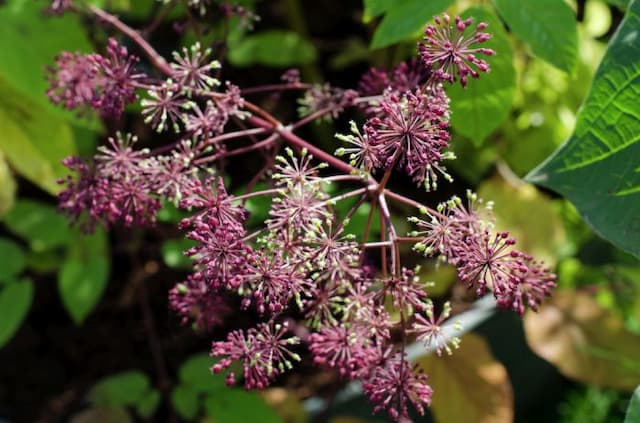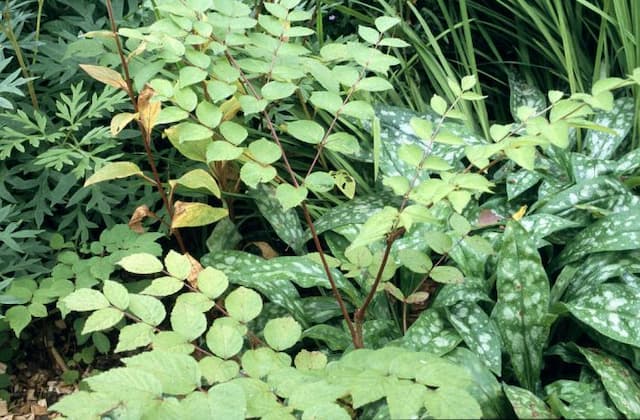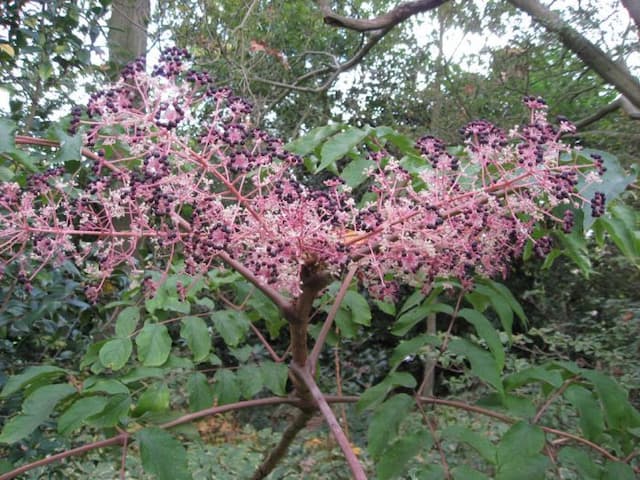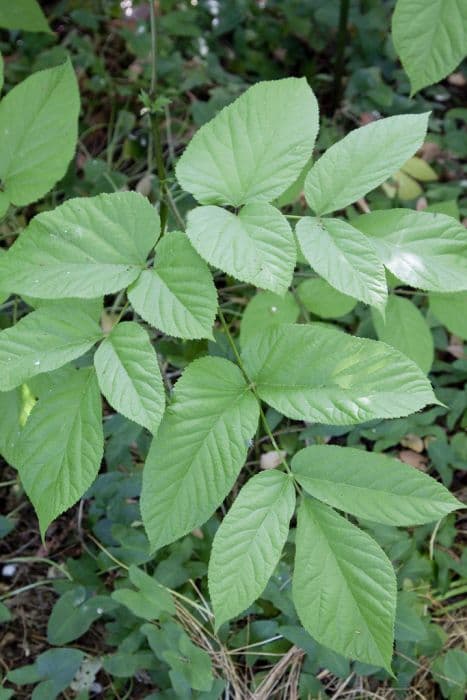Umbrella tree 'Gold Capella' Schefflera arboricola 'Gold Capella'


ABOUT
Schefflera arboricola 'Gold Capella' is a cultivar of the Schefflera genus, also known as the Dwarf umbrella tree or Parasol plant. It is a small, evergreen shrub that typically grows to a height of 16 feet.
It has a compact and bushy growth habit, with glossy, dark green leaves that are variegated with bright yellow. The leaves are palmate, meaning they are arranged like the fingers of a hand, with several leaflets radiating from a central point. The leaves are typically 2-3 inches long and wide.
The plant produces small, inconspicuous flowers that are followed by small, black fruit.
It is a popular houseplant and is commonly grown in container gardens. It is also known for its tolerance to low light conditions, and for its air purifying qualities.
About this plant
 Names
NamesFamily
Araliaceae
Synonyms
Parasol plant, Dwarf umbrella tree, Dwarf schefflera, Hawaiian umbrella tree, Octopus tree
Common names
Schefflera arboricolum 'Gold Capella'
 Toxicity
ToxicityTo humans
Schefflera arboricola 'Gold Capella' is considered to be toxic to humans if ingested, due to the presence of calcium oxalate crystals in the plant. These crystals can cause a burning sensation in the mouth, throat, and stomach, as well as difficulty swallowing, excessive drooling, and vomiting.
Skin contact with the plant may also cause irritation. It is important to keep this plant away from children and pets, and to always wash your hands after handling the plant.To pets
Schefflera arboricola 'Gold Capella' is also toxic to animals if ingested. It can cause similar symptoms as in humans such as oral irritation, excessive drooling, vomiting, and difficulty swallowing.
It's important to keep this plant away from pets and to keep an eye on them when they are around the plant. If you suspect that your pet has ingested any part of the plant, you should contact your veterinarian immediately.
 Characteristics
CharacteristicsLife cycle
Perennials
Foliage type
Evergreen
Color of leaves
Green with yellow
Flower color
Yellow to green
Height
Up to 16 feet
Spread
Up to 5 feet
Plant type
Shrub
Hardiness zones
10
Native area
Taiwan
Benefits
 General Benefits
General BenefitsThis cultivar is able to tolerate low light conditions, making it a great choice for rooms with little or no natural light;
Schefflera arboricola 'Gold Capella' has a compact growth habit and is relatively small in size, making it a great choice for small spaces or as a tabletop plant;
The plant has a compact growth habit and is relatively small in size, making it a great choice for small spaces or as a tabletop plant;
Schefflera arboricola 'Gold Capella' is easy to care for and requires minimal maintenance, making it a great option for those with limited gardening experience;
This plant is versatile and can be grown in a variety of ways such as in a container, hanging baskets, and as a bonsai plant;
The plant can tolerate dry air, making it a great option for indoor environments with low humidity. Medical Properties
Medical PropertiesUmbrella tree 'Gold Capella' has not been extensively studied for its medicinal properties:
Some studies suggest that the plant's leaves may have diuretic properties, which can help increase the production of urine and flush out excess fluids from the body;
The plant's leaves have been traditionally used to treat inflammation and pain;
Some studies have suggested that the plant may have antimicrobial properties, which can help fight off harmful microorganisms;
The plant has been traditionally used to treat a variety of ailments such as fever, headaches, and skin conditions.
Attantion, it is a toxic plant and should not be ingested, it should be used under the guidance of a healthcare professional. Air-purifying Qualities
Air-purifying QualitiesSchefflera arboricola 'Gold Capella' is known for its air-purifying qualities. It is able to remove harmful toxins from the air, such as formaldehyde, benzene, and trichloroethylene. These toxins are commonly found in household items such as cleaning products, paint, and furniture.
The plant does this through a process called phytoremediation, where it absorbs the toxins through its leaves and converts them into less harmful compounds. Other Uses
Other UsesOne unusual use of Schefflera arboricola 'Gold Capella' could be as a bonsai plant. Bonsai is the art of growing miniature trees in small pots, and it is a practice that originated in Japan. Schefflera arboricola 'Gold Capella' with its small size and compact growth habit, would make an excellent candidate for bonsai.
Interesting Facts
 Feng Shui
Feng ShuiThe plant is believed to bring good luck and prosperity when placed in the east or southeast sector of the home or office.
Also the plant's lush green leaves are believed to bring a sense of peace and calmness to a room and can be placed in areas where stress and tension are present.
It is important to note that feng shui is a personal practice and the way you apply it may vary depending on your own beliefs and preferences.
 Water
WaterIt's important to keep the soil consistently moist but not waterlogged.
A good rule of thumb is to wait until the top inch of soil is dry before watering again. It's also a good idea to allow the excess water to drain away from the pot to prevent water from sitting in the bottom of the pot. Light
LightThe Schefflera arboricola 'Gold Capella' is a tropical plant, it prefers to be kept in bright, indirect light but can tolerate low light conditions. It's best to avoid direct sunlight which can scorch the leaves.
 Temperature
TemperatureThe ideal temperature range for the Schefflera arboricola 'Gold Capella' is between 60-85°F and it is not tolerant to frost.
It is a tropical plant, so it will not survive in temperatures below freezing. Pruning
PruningWhen pruning the Schefflera arboricola 'Gold Capella', it's best to do so during the spring or summer when the plant is actively growing. Prune back any leggy or overgrown branches to encourage bushier growth. You can also remove any yellow or brown leaves to keep the plant looking healthy.
 Cleaning
CleaningOnce a month
 Soil
SoilThe best soil for the Schefflera arboricola 'Gold Capella' is a well-draining, humus-rich potting mix. You can use a commercial potting mix formulated for tropical plants or make your own by mixing equal parts peat moss, perlite, and vermiculite.
The soil pH should be slightly acidic to neutral, around 6.0-7.0. Repotting
RepottingIt's important to keep an eye on the root growth of your Schefflera arboricola 'Gold Capella' and repot it when it becomes root-bound.
A good rule is to repot the plant every 2-3 years or when you notice the roots growing out of the drainage holes. Humidity & Misting
Humidity & MistingThe humidity level that Schefflera arboricola 'Gold Capella' prefers is moderate to high, around 50-70%.
If the humidity level in your home is low, you can increase the humidity around the plant by placing a tray of water near the plant, or by misting the leaves with water. Suitable locations
Suitable locationsIndoor
All year round
Outdoor
It is a tropical plant therefore, can only be grown in tropical climates.
Choose a location with bright, indirect light for your Schefflera arboricola 'Gold Capella'. Avoid placing it in direct sunlight as it can scorch the leaves.
Choose a well-draining soil with a slightly acidic to neutral pH of 6.0-7.0
Water the plant when the top inch of soil is dry, but keep the soil consistently moist.
Fertilize the plant every 4-6 weeks during the growing season with a balanced water-soluble fertilizer.
Prune the plant as needed to encourage bushier growth and remove any yellow or brown leaves.Hardiness zone
USDA 11 - 12
 Life cycle
Life cycleThe plant begins its life cycle as a seed, which germinates and grows into a small seedling. As it matures, it develops into a larger, bushier plant with multiple branches and leaves. The Schefflera arboricola 'Gold Capella' is a slow-growing plant and can take several years to reach its mature size.
During the growing season, which is typically spring and summer, the plant will produce new leaves and may also produce small, inconspicuous flowers. In the fall and winter, the plant will enter a dormant period during which it will not produce new growth.
Throughout its life cycle, the Schefflera arboricola 'Gold Capella' requires regular care to ensure it stays healthy. This includes proper watering, fertilizing, pruning, and repotting as needed. The plant is relatively low maintenance, but it is important to keep an eye on the root growth and repot it when it becomes root-bound. Propogation
PropogationPropogation time
Spring - summer
By STEM CUTTINGS:
One of the most common methods of propagating Schefflera arboricola 'Gold Capella' is by taking stem cuttings. Cut a stem that is at least 3-4 inches long, remove the leaves from the bottom inch of the stem and insert the stem into a moist potting mix or a glass of water. Keep the cutting in a warm, bright location and wait for roots to develop, which can take several weeks. Once roots have formed, you can transplant the cutting into a container with potting mix.
By AIR LAYERING:
Another way to propagate Schefflera arboricola 'Gold Capella' is by air layering. This method involves wounding a stem, applying rooting hormone and wrapping the wounded area with a rooting medium such as sphagnum moss. Once roots have formed, you can remove the rooted section from the parent plant and pot it up.
By ROOT DIVISION:
If your Schefflera arboricola 'Gold Capella' is root-bound, you can divide the roots and propagate new plants. Carefully remove the plant from its container and separate the roots with a sharp knife. Re-pot the divisions into separate containers with potting mix.
By SEEDS:
It is also possible to propagate Schefflera arboricola 'Gold Capella' by seed. The seeds should be sown in a well-draining seed compost, covered with a layer of vermiculite and kept in a warm place at around 68-77°F.
 Pests
PestsSpider mite, Whitefly, Scale insects, Mealybug
 Diseases
DiseasesBotrytis cinerea, Root Rot, Powdery mildew









